
views
Researching Your Subject

Ask the subject for permission to write the biography. Before you dive into your research, make sure you get the okay from the subject to write their biography. Ask them if they are willing to be the subject. Getting their permission will make writing the biography much easier and ensure they are open with information about their life. If the subject does not give you permission to write the biography, you may want to choose a different subject. If you decide to publish the biography without the subject’s permission, you may be susceptible to legal action by the subject. If the subject is no longer alive, you obviously do not need to ask permission to write about them.

Look for primary sources about the subject. Primary sources could include books, letters, pictures, newspapers and newspaper clippings, magazines, internet articles, journals, videos, interviews, existing biographies, or an autobiography by the subject. Look for these sources at your local library or online. Read as much as you can about the subject and highlight any key information you come across in your sources. You may create research questions to help focus your research of the subject, such as, What do I find interesting about the subject? Why is this subject important to readers? What can I say that is new about the subject? What would I like to learn more about?

Conduct interviews with the subject and those close to them. Interviewing people will breath life into your research—people you interview can tell you stories that you can’t find in a history book. Interview the subject as well as people close to them, such as spouses, friends, business partners, family members, coworkers, and peers. Conduct the interview in person, by phone, or through e-mail. For in person interviews, record them with a tape recorder or a voice recorder on your computer or phone. You may need to interview the subject and others several times to get the material you need.

Visit locations that are important to the subject. To get a feel for the subject’s history, spend time in locations and areas that are meaningful or important to the subject. This could be the subject’s childhood home or neighborhood. You could also visit the subject’s workplace and regular hang out spots. You may also want to visit areas where the subject made a major decision or breakthrough in their life. Being physically in the area can give you a sense of how the subject might have felt and help you write their experiences more effectively.

Study the time and place of the subject’s life. Contextualize the subject’s life by looking at what was going on around them. Consider the time period they grew up in as well as the history of the places where they lived. Do research on the economics, politics, and culture of their time period. Look at the news events happening in the place where they lived or worked. When researching the time period ask yourself: What were the social norms of that time? What was going on economically and politically? How did the social and political climate affect the subject?
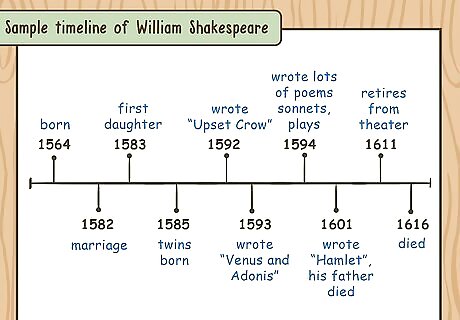
Make a timeline of the person’s life. To help you organize your research, make a timeline of the person’s entire life, starting from birth. Draw a long line on a piece of paper and fill in as much of the person’s life as you can. Highlight key events or moments on the timeline. Include important dates, locations, and names. You may also include historical events or moments that affected the subject on the timeline. For example, maybe there was a conflict or civil war that happened during the person’s life that affected their life.
Writing the Biography
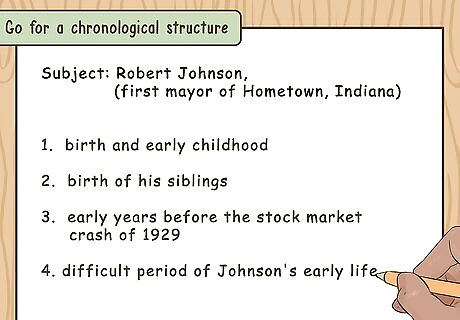
Go for a chronological structure. Start chronologically from the subject’s birth to their death or later life. Use the timeline of the person’s life to structure the biography. Start with birth and childhood. Then, go into young adulthood and adulthood. If the person is still alive, include information on their later life. If they are no longer alive, include information on their death. You may end up focusing on particular areas of the person’s life. If you do this, work through a particular period in the person’s life chronologically.
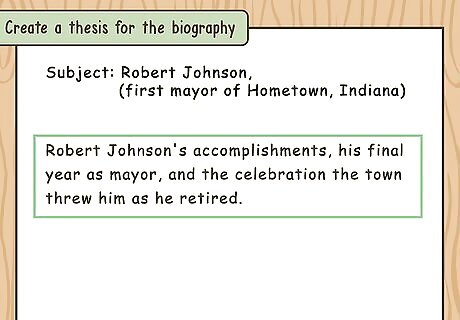
Create a thesis for the biography. It may be helpful to create a thesis statement or a sentence with your main idea for the biography. Use the thesis to help you organize the rest of the biography. Make sure all of your content refers back in some way to your thesis. For example, you may have a thesis statement about focusing on how the person impacted the civil rights movement in America in the 1970s. You can then make sure all your content relates back to this thesis.
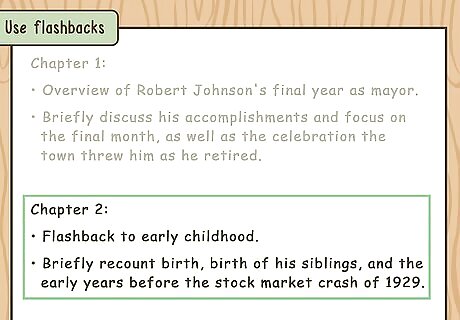
Use flashbacks. Flashbacks are when where you move from the present to the past. You may start with a present moment and then include a scene of the person’s past. Or you may have one chapter that focuses on the present and one chapter that focuses on the past, alternating as you go. Flashbacks should feel as detailed and real as present day scenes. Use your research notes and interviews with the subject to get a good sense of their past for the flashbacks. For example, you may jump from the person’s death in the present to a flashback to their favorite childhood memory.
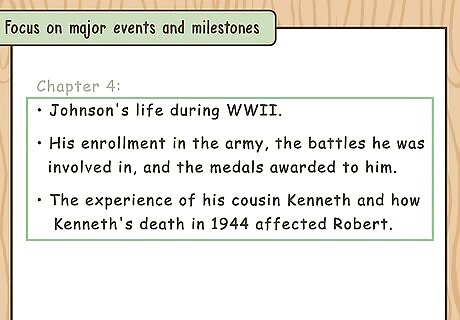
Focus on major events and milestones. Major events could include marriages, births, or deaths in the person’s life. They may also have milestones like their first successful business venture or their first civil rights march. Highlight key moments in the person’s life so the reader gets a good sense of what mattered to the person and how they affected the world around them. For example, you may focus on the person’s accomplishments in the civil rights movement. You may write a whole section about their contributions and participation in major civil rights marches in their hometown.

Identify a major theme or pattern in the person’s life. Look over your research for any similarities between events or moments in the person’s life. Check for any recurring phrases or situations in the person’s life. For example, you may notice that the person’s life is patterned with moments of adversity, where the person worked hard and fought against larger forces. You can then use the theme of overcoming adversity in the biography.
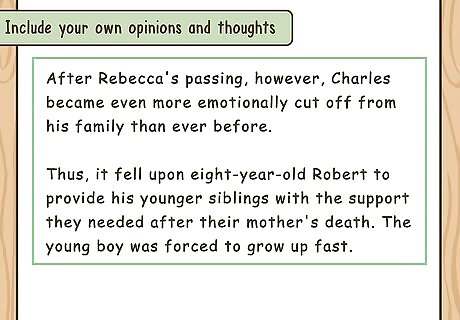
Include your own opinions and thoughts about the person. As the biographer, you play a role in the person’s life story. Do not be afraid to put your own thoughts about the person in the text. Reflect on your research and comment on how you view the person. For example, you may note how you see parallels in the person’s life during the civil rights movement with your own interests in social justice. You may also commend the person for their hard work and positive impact on society.
Polishing the Biography

Show the biography to others for feedback. Once you have completed a draft of the biography, show it to peers, friends, teachers, and mentors for feedback. Ask them if they get a good sense of the person’s life and if the biography is easy to read. Be open to feedback so you can improve the biography and make it better. Revise the biography based on feedback from others. Do not be afraid to cut or edit down the biography to suit the needs of your readers.

Proofread the biography. Check the biography for spelling, grammar, and punctuation. Circle all punctuation in the text to confirm it is correct. Read the text backwards to check for spelling and grammar errors. Having a biography riddled with spelling, grammar, and punctuation errors can turn off your readers and result in a poor grade if you are handing in the text for a class.
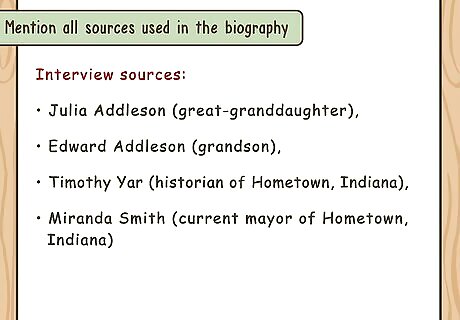
Cite all sources used in the biography. Most biographies will include information from sources such as books, articles, magazines, and interviews. Make sure you cite any sources you quote directly or paraphrase. You may use in-text citations, footnotes, or endnotes. If the biography is for a class, use MLA, APA, or Chicago Style citations based on the preferences of your instructor.




















Comments
0 comment